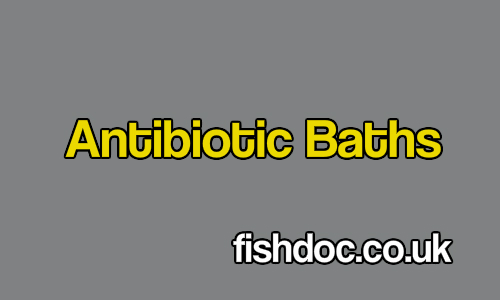Fish disease and antibiotics
Antibiotic baths or dips provide another route for the treatment of bacterial fish diseases. However, baths and dips are not as effective as medicated food or injections for treating systemic infections or advanced ulceration. In general the best results come from antibiotic injections.
Baths and dips are probably best used for surface infections such as fin rot, bacterial gill disease and columnaris (cotton wool disease), where short duration baths with high dosages may be useful.
Antibiotic absorption
There are conflicting reports about how effectively antibiotics are absorbed into the blood from bath and dip treatments. The best absorbed seem to be the nitrofuran antibiotics such as nifurpirinol and nitrofurazone. The absorption of other antibiotics is generally poor, which is why such treatments often fail against advanced and systemic bacterial infections.
Antibiotics and biological filtration:
In general all antibiotics will have an adverse effect on nitrifying bacteria, which means that treatment has to be carried out outside the tank or pond. For longer-term bath treatments, this will severely restrict the numbers of fish that can be treated if ammonia levels are to be kept to an acceptable level without biological filtration. It is important to test and monitor water quality during prolonged treatments. Should water changes be required, the top-up water should contain the appropriate amount of drug
Purity
It is important to use the purest possible drugs to avoid any side effects from carrier compounds.
Chelation in hard water
Many antibiotics chelate divalent cations such as magnesium and calcium, causing their inactivation. This is particularly the case with all tetracyclines and quinolones such as oxolinic acid and enrofloxacin. Higher doses of these drugs should be used when treating fish in hard water
Dosage
Antibiotics used as bath treatment against bacterial disease in ornamental fish
enrofloxacin bath: 2 mg/litre for five days
oxolinic acid bath: 25mg / litre for 15 minutes. Repeat twice daily for 3 days
oxytetracycline bath: 13-120 mg/ litre
neomycin bath: 66 mg/litre – repeat every three days for up to three treatments
nifurpirinol 66 mg/ litre. Repeat every three days for up to three treatments
nitrofurazone
- 100mg / litre for 30 minutes
- 10mg/litre for 6 – 12 hours
- 2mg/litre prolonged immersion for 5 – 10 days
# nitrofuran antibiotics are prohibited in the UK for use in food-animals
Note: When using oxytetracycline in long-term baths, be aware that it is light sensitive and will start to turn brown as it decomposes. If this happens, a 50% water change should be carried out immediately. Degraded tetracycline can be harmful to humans so avoid contact by wearing gloves.
POTASSIUM PERMANGANATE FOR INFECTIONS >

